Note: The following is a summary of the PPIC report, “Where the Wild Things Aren’t: Making the Delta a Better Place for Native Species,” and is not intended to be considered an endorsement of the report or its contents.
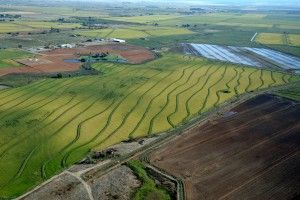 In June of 2012, the team of researchers at the Public Policy Institute of California released the report, “Where the Wild Things Aren’t: Making the Delta a Better Place for Native Species,” which proposes a plan for managing the Delta that would meet the coequal goals and restore populations of native species while also preserving human uses (referred to hereafter as “the Plan”). The Plan proposes to accomplish this by specializing different areas of the Delta for different habitats and uses, restoring some of the natural variability in water flows that existed historically, reconfiguring and reoperating the existing infrastructure to serve multiple environmental objectives, managing invasive species and changing hatchery operations. The ecosystem that will emerge will be novel in many ways, and given the uncertainties of such an evolving ecosystem, a strong program of adaptive management that integrates modeling, experimentation, and feedback into management decisions will be required.
In June of 2012, the team of researchers at the Public Policy Institute of California released the report, “Where the Wild Things Aren’t: Making the Delta a Better Place for Native Species,” which proposes a plan for managing the Delta that would meet the coequal goals and restore populations of native species while also preserving human uses (referred to hereafter as “the Plan”). The Plan proposes to accomplish this by specializing different areas of the Delta for different habitats and uses, restoring some of the natural variability in water flows that existed historically, reconfiguring and reoperating the existing infrastructure to serve multiple environmental objectives, managing invasive species and changing hatchery operations. The ecosystem that will emerge will be novel in many ways, and given the uncertainties of such an evolving ecosystem, a strong program of adaptive management that integrates modeling, experimentation, and feedback into management decisions will be required.
RECONCILIATION ECOLOGY: A NEW STRATEGY FOR THE DELTA
The Plan is based around the concept of ‘reconciliation ecology’, an approach that accepts that the Delta’s ecosystem has been irrevocably changed and a return to its pre-development state just is not possible. At the same time, this approach acknowledges that human uses of the Delta are going to continue: levees will still be needed for flood protection, the deep water shipping channels will still be used to access the inland ports, water will still be diverted from the system for agricultural and urban use, and wastewater treatment plants will still continue to discharge into the Delta. Therefore, a new, novel ecosystem must be created and managed where human uses and species can coexist.
However, a reconciliation approach is not without tradeoffs. The PPIC’s vision for a reconciled Delta will involve some sacrifices from society to better support the environment, and mitigation may be appropriate for groups who may be impacted by lands being returned to habitat or subjected to permanent flooding. Reconciliation also means being realistic about supporting native species, as the report states: “[R]estoration of abundant populations of all native species is unlikely if present trends continue. Some species may become extinct in the wild even if society undertakes extraordinary efforts to sustain them. By supporting ecosystem functions that favor native species, reconciliation is the most promising approach for sustaining most native species in the highly altered environment where they now live.”
- The term “reconciliation ecology” was articulated by Michael Rosenzweig, Professor of Ecology & Evolutionary Biology at the University of Arizona, Tucson. Click here to visit his website.
SPECIALIZED ENVIRONMENTS: CREATING THE PLACES WHERE THE WILD THINGS WANT TO BE
Lying at the confluence of the state’s two largest rivers and three smaller ones, the Delta before reclamation was a complex region of floodplains, tidal marshes and riparian habitat. Although most of this historical habitat has been altered or converted to other uses, the Delta of today still retains a variety of distinctive and diverse habitats that vary depending on the elevation above sea level and the land’s access to water flows, sediment, nutrients and tidal energy.
Fragments of essential habitat for native species remain primarily in the north and western Delta. Other parts of the Delta, such as the central Delta’s flooded islands, have evolved to become more hospitable to non-native species that support recreational fisheries. A key strategy for reconciling the Delta, then, is to capitalize on these differences by specializing regions to support desired uses, depending upon the particular physical and biological characteristics of the land involved: “Area specialization can provide the ecosystem diversity and variability that native fishes (and other organisms) need, while supporting continued human uses of Delta land and waters.”
The Plan proposes to divide the Delta into four specialized regions:
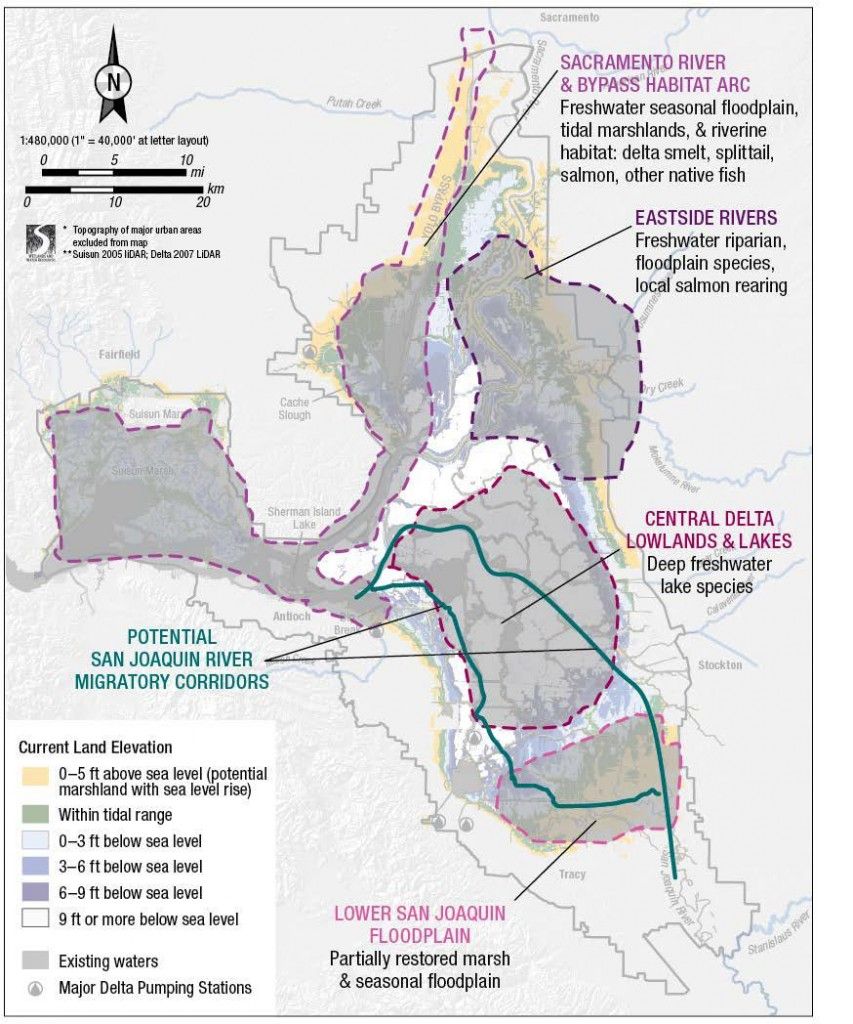
SOURCE: PPIC Where the Wild Things Aren’t, Figure 4, pg. 29
- Sacramento River and Bypass Habitat Arc: The western and northern Delta would be an arc of tidally connected habitats extending from Suisun Marsh and Big Break into the Yolo Bypass and parts of the northwestern Delta. This habitat arc would be specialized to support native species and recreation.
- Lower San Joaquin Floodplains: The southern Delta would be primarily non-tidal brackish marsh and seasonal floodplains fed by the San Joaquin River that would support migratory birds and provide rearing habitat for salmon. Additional floodplains in this area would also have flood management benefits for the lower San Joaquin River and communities in the Stockton-Lathrop area.
- Eastside Rivers: The eastern and northern Delta would be specialized to have riparian and seasonal floodplain habitat along the Consumnes and Mokelumne river corridors to support spawning and rearing of fish; this strategy would take advantage of freshwater flows from the unregulated Consumnes River to provide variability and sediment needed to support these habitats.
- Central Delta Lowlands and Lakes: The central Delta’s flooded islands resemble freshwater lakes dominated by invasive aquatic vegetation and non-native freshwater fishes such as largemouth bass and sunfish. This area of the Delta currently is and would continue to be favorable habitat for non-native freshwater fishes which have recreational value. However, some of these species are predators of native species, so steps will need to be taken to steer native species away from this area.
MANAGEMENT TOOLS FOR A RECONCILED DELTA
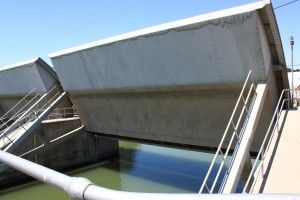 The process of reconciliation will require coordination of a wide range of activities while at the same time, continued change in the Delta will require management responses. Therefore, a variety of tools will be needed in order to implement the reconciliation process:
The process of reconciliation will require coordination of a wide range of activities while at the same time, continued change in the Delta will require management responses. Therefore, a variety of tools will be needed in order to implement the reconciliation process:
- Restore more variable flows: A strong pattern of seasonal and year-to-year variability in river flows is a defining characteristic of California’s climate in which the Delta’s native species evolved and thrived. However, conversion of the landscape for human uses, along with water supply and flood control infrastructure needed to support those uses has created stable, artificially regulated conditions that are very different from historical natural flows. Therefore, a central part of the reconciliation approach is to reintroduce some of the variability in the seasonal flows and from year to year by managing inflows and diversions in ways that are consistent with key elements of the historical flow regime. If timed correctly, this variability would support native species and their habitats while disrupting the stable conditions preferred by invasive species.
- Reoperate/reconfigure existing infrastructure: The Delta’s islands, levees, channels and gates are essential components of the reconciliation process as they can be used to manipulate environmental flows by steering water, sediments, nutrients, fish and tidal energy toward some areas and away from others. They can also be used to affect the frequency of inundation of floodplains. However, to reestablish natural functions, some changes in levees and flows will be required, and new experimental ways of using the existing infrastructure to meet multiple environmental objectives will need to be developed.
- New conveyance: Much of the time, the flows in the channels of the south Delta are toward the pumps, increasing the probably of fish being drawn towards and entrained in the pumps, as well as loss of fish due to predation. The report notes: “If properly designed and operated, a tunnel under the Delta or a canal around its periphery would provide increased flexibility in the operation of diversions, increasing the compatibility of water exports with ecosystem management. To date, however, there have been insufficient descriptions of operational criteria of an isolated of dual conveyance facility to assess its potential for ecosystem reconciliation.” The report also notes that if water exports continue without an isolated conveyance, there will be a continued risk of fish entrainment at the south Delta pumps and the large volumes of exports from the south Delta will continue to disrupt natural flow patterns: “Ecosystem reconciliation in the Delta will be more difficult without some suitably operated form of isolated conveyance.”
- Land Conversions: The vision of specialization involves conversion of some lands currently being used for other purposes to marshland and seasonal floodplains. Some additional upland and terrestrial habitat will be needed to support native birds and other terrestrial species. Habitat acquisition has been discussed for years, and the BDCP proposes to restore up to 113,000 acres. However, the report warns “In the rush to improve environmental conditions in the Delta, there is a danger that policymakers are focusing more on the quantity of new habitat than on its quality and location. It will be essential to select areas that can support the desired ecological processes, taking into account not only land elevations, but also access to appropriate flows, sediment, nutrients, and tidal energy.”
- Water Quality Improvements: The future Delta’s water quality will vary due to many factors, including flow management, regulation of discharges, sediment imbalances, and salinity and selenium issues from San Joaquin drainage; therefore, extensive modeling, data collection and experimentation will be needed to understand their effects and interactions on water quality. Besides flow manipulation, additional treatment of urban wastewater and stormwater, management of agricultural drainage on the farm, and reducing pollutant loading can be used to manage and improve water quality.
- Hatchery Operations: Hatcheries have been used to mitigate the effects of overfishing, habitat destruction and the loss of spawning habitat, and have sustained fisheries for decades, but they have done so at the expense of wild populations. Displacement and interbreeding by hatchery fish contributes to the reductions in wild populations, and hatchery fish are less well-adapted for reproducing and surviving in the wild, making them more vulnerable to unfavorable environmental conditions. Therefore, the Plan proposes significant changes for hatchery operations. The Plan argues that the conservation and production functions of the hatcheries to be separated and proposes that only wild fish be allowed to spawn in the rivers, so either hatchery production be either drastically reduced or eliminated, or that all hatchery juveniles be reared in cages in cages in the estuary where the adults would return to the vicinity and a terminal commercial fishery could exist.
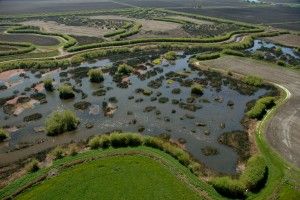 The process of reconciling the Delta won’t happen overnight. While there would be some near-term benefits, most changes will take decades to implement and even longer to become fully effective. Acquisition of suitable areas for habitat restoration could take decades, and functional recovery of those habitats even longer. A new conveyance facility is at least a decade away as are upgrades to urban wastewater treatment plants.
The process of reconciling the Delta won’t happen overnight. While there would be some near-term benefits, most changes will take decades to implement and even longer to become fully effective. Acquisition of suitable areas for habitat restoration could take decades, and functional recovery of those habitats even longer. A new conveyance facility is at least a decade away as are upgrades to urban wastewater treatment plants.
In the meantime, there will be much to learn about the new, evolving ecosystems, and climate change, rising sea levels, and other forces will continue to bring change to the Delta. Managing with this uncertainty will be difficult, and will surely produce surprises and disappointments. Therefore, achieving the desired outcome will require an adaptive management strategy that is designed to integrate modeling, experimentation, and feedback into management decisions. We’re going to have to go forward despite the uncertainty, the Plan points out: “Overnegotiation of details in advance is unlikely to enable adequate responsiveness and flexibility.” Given the history of conflict in the Delta, implementing adaptive management will be challenging, at best, but it must be undertaken: “The choice is stark: we must either make adaptive management work, or accept that future development and restoration work will likely produce undesirable outcomes.”
In order to be effective, a new scientific culture needs to be developed, one where diverse scientists and technical experts work together to explore and develop solutions to the Delta’s problems, and so the Plan proposes forming a Delta Adaptive Management Alliance (Delta AMA) that is coordinated and guided by the Delta Science Program. The Delta AMA would coordinate the efforts of the wide range of entities involved in ecosystem restoration, including integration and synthesis of scientific and technical knowledge, the pooling of resources, and research and development.
IN CONCLUSION …
The conflicts over ecosystem, land and water resource management in the Delta are urgent and worsening, and given the substantial changes the region has undergone since reclamation for human use, it isn’t even possible to restore the Delta to the condition it was just a few decades ago, let alone restore it to its pre-development condition, the Plan argues. Furthermore, sea level rise, climate change, land subsidence, earthquakes, and invasive species will continue to bring changes to the Delta, making it impossible to preserve it even in its current state. Therefore, plans for the Delta must prepare for change and adaptation.
The Plan proposes a path forward for the Delta that will meet the coequal goals and is compatible with state and federal environmental law, the objectives and authorities of the State Water Resources Control Board and the objectives of the Delta Stewardship Council’s Delta Plan. Some recommendations in the report do present some legal issues: the proposals need to be evaluated for consistency with existing state and federal flood control policies, removal or relocation of levees would require permits from the Army Corps of Engineers, and changes may be needed in water rights, waste discharge permits and National Pollution Discharge Elimination System (NPDES) permits. Additionally, some of the proposed changes could cause economic harm to some individuals or communities and mitigation may be required.
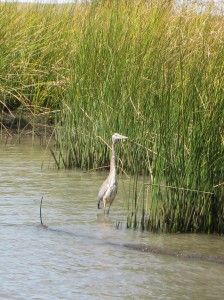 Ecosystem reconciliation is a promising approach for addressing the Delta’s problems that implies a need to accept both the human and environmental uses of the Delta and recognizes that many of the major human features of the landscape will remain. However, there will be tradeoffs and tough decisions to be made. The Plan acknowledges that a reconciliation approach won’t eliminate conflict, but will provide a constructive framework for seeking improvements: “Ecological reconciliation may be expensive, but it is likely to be less costly and more environmentally effective over the long term than a series of reactive responses to continuing crises in the Delta. Ecological investments in the Delta will ultimately benefit California’s economy by securing higher-quality, more reliable water for agriculture and urban use, averting expensive responses to natural disasters, and expanding recreational opportunities. Ecosystem and economic objectives are mutually dependent. Laying out a strategic direction that recognizes this interdependence is necessary to guide effective plans and policies.”
Ecosystem reconciliation is a promising approach for addressing the Delta’s problems that implies a need to accept both the human and environmental uses of the Delta and recognizes that many of the major human features of the landscape will remain. However, there will be tradeoffs and tough decisions to be made. The Plan acknowledges that a reconciliation approach won’t eliminate conflict, but will provide a constructive framework for seeking improvements: “Ecological reconciliation may be expensive, but it is likely to be less costly and more environmentally effective over the long term than a series of reactive responses to continuing crises in the Delta. Ecological investments in the Delta will ultimately benefit California’s economy by securing higher-quality, more reliable water for agriculture and urban use, averting expensive responses to natural disasters, and expanding recreational opportunities. Ecosystem and economic objectives are mutually dependent. Laying out a strategic direction that recognizes this interdependence is necessary to guide effective plans and policies.”
- Read the full report, Where the Wild Things Aren’t: Making the Delta a Better Place for Native Species, by clicking here.

